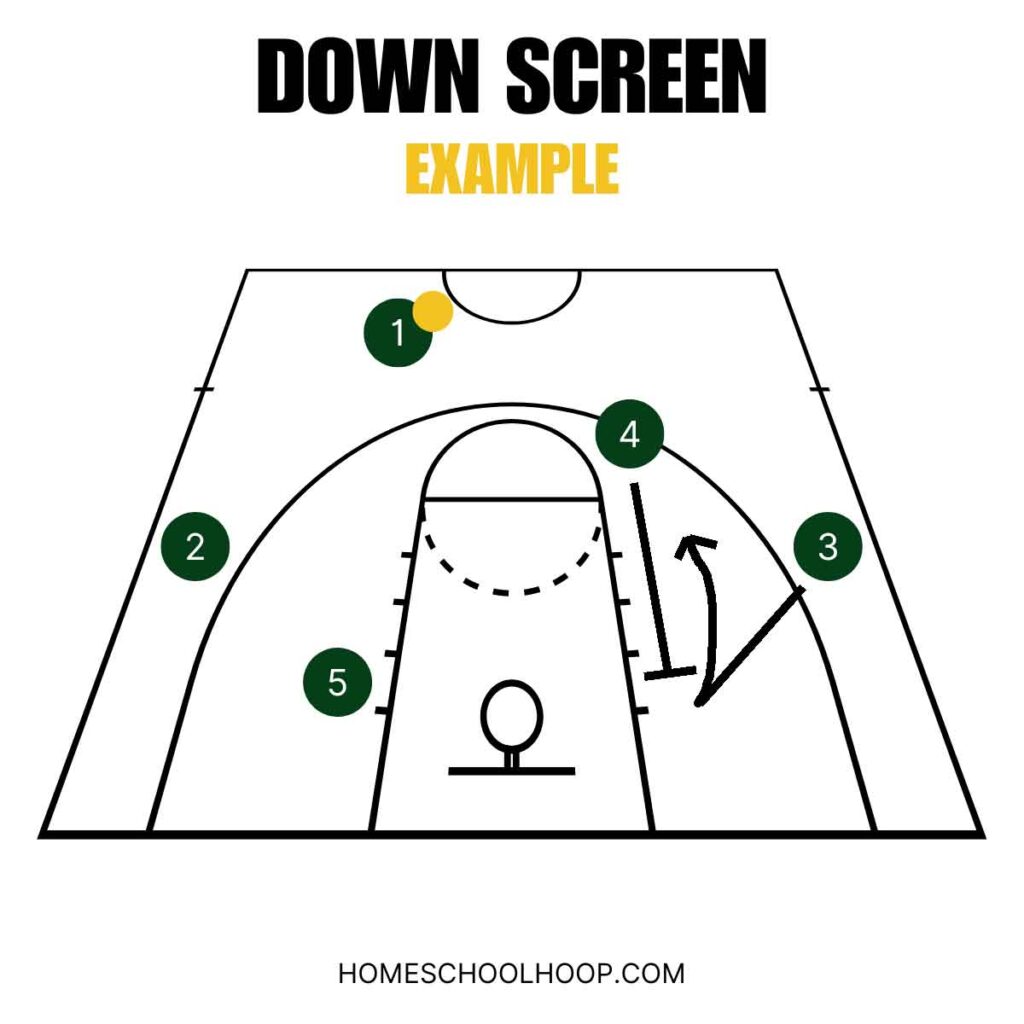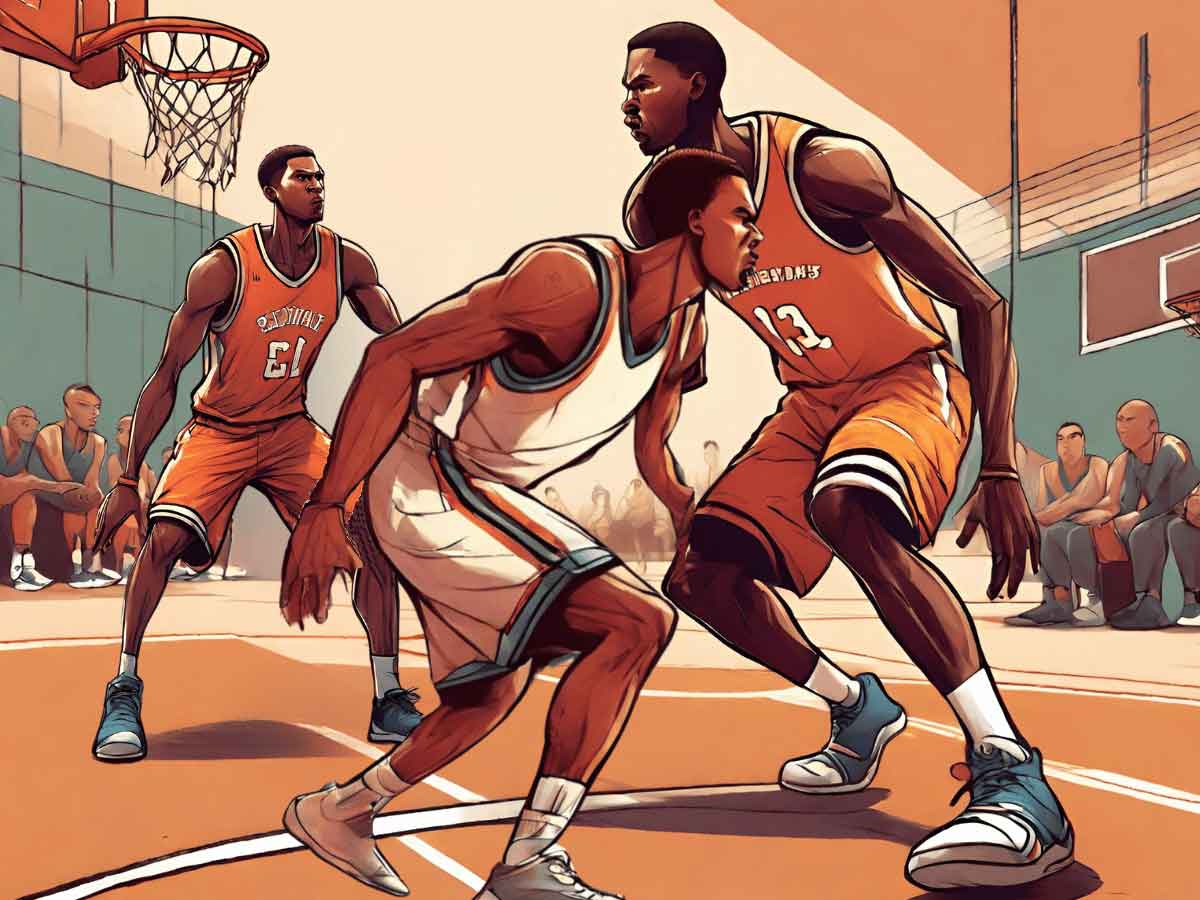In basketball, using screens is a key tactic for any team’s offense. Among these, the down screen in basketball is especially common and effective for helping players get away from their defenders and opening up chances to score.
Key Takeaways:
- What Are Down Screens? A down screen in basketball is a type of off-ball screen where one player screens down toward the baseline for their teammate to cut toward the ball.
- Why Use Down Screens? This move creates more room for a player to catch a pass and possibly take an open outside shot.
- How to Do It Right: To make a down screen work, players need to hit the right angles, understand when to move, and talk to each other so everyone is in sync.
Here, we’re going to look closely at how to set up and use down screens effectively, why they’re a good strategy to include in your game plan, and what common errors you should try to avoid.
What is a Down Screen in Basketball?
A down screen is an offensive tactic used in basketball to create open space for a player to shoot. The technique involves one player coming from the top of the key or the wing and moving down toward the baseline to set a screen for a teammate, who uses the screen to cut toward the ball.
Another term for a down screen is pin down, which emphasizes the action of pinning an offensive player’s defender near the baseline to create open space.
Teams most often use a down screen to get an open perimeter shot for a great outside shooter (like the Golden State Warriors do for Stephen Curry). You’ll often see it when teams need a last-second basket.

The basic concept:
- How it Works: A down screen occurs away from the ball, with the screener moving toward the baseline to pin down a teammate’s defender.
- What it Does: Like is the case with a ball screen, the goal of this type of basketball screen is to free up a teammate from their defender, allowing them to move toward an open area away from the basket for an open outside shot.
Mechanics of Setting a Down Screen
Setting a down screen involves a coordinated effort from both the screener and the cutter. Here’s how it’s done:
- Positioning: The cutter sets up their defender by sliding in toward the rim. Simultaneously, the screener turns away from the ball and moves toward the baseline.
- Execution: The screener sets themselves square to the defender, creating a barrier. The cutter, in turn, uses the screen to break free from the defender.
The Benefits of Using Down Screens
Down screens are integrated into offensive schemes and out-of-bounds plays because they’re effective at creating scoring opportunities and improving court spacing.
Creating Open Shots and Scoring Opportunities
Down screens are useful for generating open scoring chances. Here’s how:
- Freeing up shooters: By using a down screen, a shooter can shake off their defender, getting open for a clear shot. This type of screen in basketball is particularly useful for freeing a great shooter for a three-point field goal attempt.
- Diversifying the offense: Incorporating down screens keeps the defense guessing and on their goes, leading to more scoring opportunities as defenders struggle to keep up and anticipate the next move.
Enhancing Court Spacing
Outside of open shot opportunities, down screens can also contribute to a team’s offense through better court spacing. Here’s what that looks like:
- Opening the floor: Down screens force defenders to adjust, creating more space on the floor to move the ball within an offensive play.
- Improving team dynamics: With better spacing, players can get into a better offensive rhythm. They’re able to move more freely and more easily make strategic decisions.
Types of Down Screens
The down screen in basketball comes with several variations. Each is suited to different play styles and situations. Three of the most common types are the single down screen, double down screen, and staggered down screen.
- Single Down Screen: This involves one player moving toward the baseline to set a screen for a teammate.
- Double Down Screen: This takes the concept a step further by using two screeners. Two players move toward the baseline and position themselves to screen either side-by-side or one behind the other. This creates a more substantial barrier, giving the cutter a better chance of shaking off their defender.
- Staggered Down Screen: This involves a sequence of down screens set by multiple players. Two (or more) players position themselves at different spots leading toward the baseline to set sequential screens. This staggered setup creates multiple options for the cutter.
Executing a Perfect Down Screen: Techniques and Tips
For a down screen to be effective, players must nail the technique. Here, we cover essential aspects such as the screener’s positioning, how the cutter should move, and the importance of communication.
Screener’s Positioning and Footwork
The success of a down screen largely depends on the screener’s ability to position themselves effectively. Here’s how:
- Stance: Keep your feet shoulder-width apart to stay stable. Tuck your arms and legs in to avoid penalties for moving screen fouls.
- Body Angle: Position your body square to the defender you’re screening, allowing your shoulders and hips to block their path.
- Location: Stand close to the defender but give them at least a stride of space.
Proper Setup and Cut by the Cutter
Just as important to an effective down screen is a quality setup and execution by the cutter. This includes:
- Fake Cut: Start by stepping into the defender’s body. This fake cut forces the defender to back up slightly and creates space.
- Wait for the Right Time: Wait until the screener is firmly in place before making your move.
- Come Off the Screen: Explode off the hip of the screen sharp and tight, leaving no room for the defender to slip between you and the screener.
- Be Ready to Shoot: As you find an open spot, ready yourself to shoot by positioning your feet and body correctly, so you’re set to go once you catch the ball.
Communication Between Screener and Cutter
The effectiveness of a down screen also depends on good communication.
- Verbal cues: Use agreed-upon words like “Use me” to let the cutter know it’s time to move. This phrase signals the screener is in position.
- Non-verbal cues: Eye contact or hand signals can silently coordinate your actions, keeping the defense in the dark.
6 Common Mistakes to Avoid When Setting Down Screens
There are common pitfalls you’ll want to steer clear of when executing down screens. Paying attention to these mistakes will make your screens more effective.
#1 Cutting Too Early
If you’re the cutter, wait until the screener is set and ready before coming off the screen. Moving too soon can lead to an illegal screen call.
#2 Not Being Set
When you’re a screener, ensure you are stationary and have your set before the cutter uses the screen. Shifting your position can result in a foul.
#3 Extending Arms or Legs
Keep your limbs close to your body when you’re the screener. Extending them out to impede the defender will almost always lead to a foul call.
#4 Screening Too Early or Late
The cutter must be ready and in position to use the screen. Screen too early, and the defense adjusts; too late, the opportunity is missed.
#5 Too Much Distance
If as the screener you’re too far from the defender, the screen won’t effectively open up space.
#6 Lack of communication
Failure to communicate can lead to confusion, resulting in poor execution of the screen.
How Defenders Can Combat Down Screens
When facing an offense that uses off-ball screens like the down screen, you usually have two primary strategies you can use to counter the action. These two tactics are switching and fighting through screens.
Switching on Screens
Switching is a straightforward yet effective way to defend a down screen. When a screen is set, the defender originally guarding the screener switches to guard the cutter, and vice versa.
This tactic works well because it prevents the cutter from getting open, disrupting the offense’s flow.
But one major risk with switching screens is that it can lead to mismatches. If a large post player screens for a quick guard, for instance, you can get caught in serious defensive trouble if you switch.
With this in mind, switching is most effective when the offensive players involved in the screen are similar in size and skill.
Fighting Through Screens
To avoid mismatch issues, most teams opt to fight through down screens. In this tactic, the defender works to stay with their original player by moving quickly around or through the screen. This method of defending screens is ideal because it maintains defensive assignments.
For this to work, both defenders have to anticipate the screen. The player guarding the screener must “open up” and give space for their defending teammate to shoot the gap and pass through the screen. The player guarding the screener has to have some agility and quickness to fight through quickly enough.
FAQs About Down Screens in Basketball
What does down screen mean?
A down screen means a player moves down toward the baseline to set an off-ball screen for a teammate, who comes off the screen and cuts toward the ball.
What is the difference between a pin down and a down screen?
A pin down and a down screen are essentially the same thing. Both terms describe a situation where a player sets a screen toward the baseline to free up a teammate. The term “pin down” emphasizes the action of pinning the defender down, while “down screen” refers to the direction of the screen.
What are the options off a down screen?
Off a down screen, a cutter generally has four options: 1) They can pop out to the perimeter to receive a pass for a jump shot or three-pointer, 2) They can curl the screen to catch the ball near the rim, 3) They can flare for an outside shot if they see their defender anticipate the screen, or 4) They can reject the screen and cut opposite of it to create a different scoring opportunity.
LET US KNOW
Today, you learned about the down screen in basketball.
So we want to know: Do you have any tips or techniques for setting or using down screens that weren’t covered in this article?
Share your insights or personal experiences in the comments.

